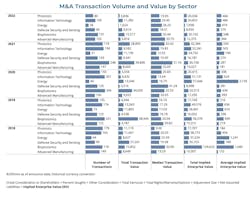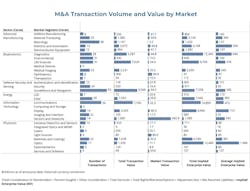2022 was an interesting year for mergers and acquisitions (M&A) across the photonics community. Inflation and rapid interest rate hikes, geopolitical instability in Europe and China, losses in both stock and bond markets, supply chain risk, and labor shortages all impacted the 2022 photonics M&A market. Yet, strategic buyers continued to acquire companies to open new markets, enhance capabilities, implement new business models, and secure supply chains.
M&A transactions are researched with announce dates from January 1 to December 31, 2022. Activity and valuations are analyzed by market segments. Values are in $US at historical rates of exchange. Implied Enterprise Value (IEV) is defined as the total consideration to shareholders (adjusted for % acquired) plus earn-outs plus rights/warrants/options plus size adjustment plus net assumed liabilities.
49,633 transactions worth $3.1 trillion are announced globally in 2022. Of that, CERES identifies and researches 553 transactions with reported value of $48 billion in the photonics industry and vertical markets employing photonics technologies as core differentiators. Overall, the 2022 M&A market is down 33% and 14% in total transaction size and count, respectively, from the previous year, as compared to down 55% and 41%, respectively, for the photonics M&A market.The total and average IEV of targets reporting financial data are $95 billion and $435 million, respectively. The median transaction value is $26 million. Consistent with previous years, the biophotonics sector sees the most activity and highest total value of all photonics-enabled sectors. Due to the relatively high research and development costs and risks, companies serving these markets are highly dependent on inorganic growth and competencies in M&A.
Pureplay photonics activity
While total and average value, as well as number, of transactions are down substantially from previous years’ highs, there are more strategic vertical integration plays and more private equity buyers.
Besides Hamamatsu Photonics’ acquisition of NKT Photonics (Denmark), vertical integration plays dominate within the lasers market. BluGlass, Penta Laser, TRUMPF, Luminar Technologies, MARKTEC, and Amplitude Systèmes all strengthen supply chains and competitive advantage with the acquisition of a laser supplier.
Prior to 2021, most acquisitions within the cameras, detectors, and sensors market are horizontal integration plays to expand the scope of product offerings. The majority of acquisitions now are vertical integration plays to secure supply chain. One of the largest pure-play photonics transactions is Compagnie de SaintGobain S.A.’s divesture of its crystals and detectors business to Edgeware Capital Management LLC and SK Capital Partners.
The largest optics transaction was Ametek’s acquisition of optical subassembly supplier Navitar Inc.
With its acquisition of two mass spectrometry companies, two life sciences process automation providers, a nanoflow liquid chromatography supplier, and two companies with diagnostic and discovery products targeting brain diseases and neurotherapeutics, Bruker Corp. was the most active buyer.
Road ahead
Looking to 2023, proactive buyers may take some risk in the near term and engage with sellers’ new mindsets around valuation. Less aggressive buyers may wait until mid-year for clarity on where inflation, interest rates, and unemployment will land.
Uncertainty, is generally not good for M&A. However, this could be the best time for well capitalized strategic buyers to do deals. For financial buyers, who are more reliant on financial markets to raise capital from Limited Partners and secure debt, it will be more challenging.
Strategic buyers of companies with core photonics technology need to address the challenges of growth. The benefits of inorganic growth are amplified in this environment where technical and management talent are scarce, R&D budgets are low and disruptions in the supply chain continue to impede meeting customer demand. So, it follows that strategic buyers may not execute highly leveraged consolidation plays, but they will continue to execute smaller capabilities and vertical integration deals.

Linda Smith | President, Ceres Technology Advisors
Linda Smith is a recognized leader in M&A advisory. Spanning the spectrum of photonics-enabled markets, she advised on acquisitions and financings valued at more than $1.5 billion. She founded CERES in 2005 to serve photonics companies underserved by generalist investment bankers. Prior, she held product management, engineering, and sales positions at public and private equity-financed photonics companies.


